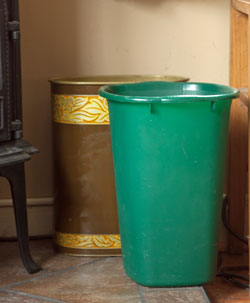Choosing and using paper wisely
Our use of paper directly affects our own health, our forests, and global warming.
Reduce
Here are some ways we reduce our use of paper:
Not using it at all
The easiest way to save paper is not to use it at all. Not everything really needs to be printed out! Years ago, when we were really getting into all the information available on the web, we printed out everything to save it. I have binders full of information on butterflies, birds, etc. etc. But what do I do when I want to know something? I go to the internet and look it up (often on Our Habitat Garden website where I store all my favorite links)! When I have time, I've been going through these binders, rescuing the paper that is blank on one side and recycling the rest. Originally, a waste of paper, for years, a waste of space, and now a waste of my time.
And we've never printed out our email. I've always wondered why people still put that tagline about "Please don't print out this email." Do people actually print their emails? Apparently they do. Why? Not many are deathless prose that you'd want to keep. The important points can be quickly jotted on a piece of paper if needed. So we agree: Think before you print!
With our computer and printer
On our PC we use FinePrint, a software program that allows us to easily print two (or more) pages on a side, print on both sides, delete unwanted pages etc. before printing, print in booklet form as well as many other printing tricks. We've saved a lot of paper, ink, and money when we used this program, and it's very affordable. Even though there are adjustment that can be made when we print from our Mac, they aren't nearly as useful as those of FinePrint. If they came out with FinePrint for Mac, I'd buy it instantly!
We decrease the size of margins, use single space or 1-1/2 space instead of double spacing, and sometimes use a smaller font. With a little care, we often get the whole document on one page instead of two.
We use both sides of the paper.
For some uses, if the document fits on one side of a page, we format it as two columns and then print the same document on the other side. We cut it in half so that half of the text is on the front of the half-sheet and the rest is on the back. We just reduced our paper use by half! This is especially useful when printing out agendas for group meetings. These generally fit on one side of the page, so it's easy to make them fit on a half-page, front and back. It takes a little thought the first time we did it, but now it's become routine (and for meetings for which we regularly use an agenda, such as for Toastmasters, we simply save it as a template.
In some documents, it makes sense to format text in columns. It often takes less space and can be easier to read.
Junk mail
Junk mail was becoming a major source of our paper waste. We'd take it from the mail box and dump it directly into the recycling basket. What we did about it …
Reuse
We save paper that is blank on one side and reuse them. If it's not crumpled, our printer has always worked just fine using this "pre-used" paper. We likely have a lifetime supply of this stuff.
We save any paper we get at meetings (for example, agendas that are printed on just one side), paper than comes in the mail (a good use for junkmail, though we're getting less of it), and lots of paper from our children's school years, and though our children are now in their late 20s and early 30s, we still are using some of their grade school worksheets.
I think this is one of those cases where keeping stuff makes good sense even though it takes space. I couldn't stand to throw away—or even recycle—perfectly good paper.
Recycle
 ©Janet Allen
©Janet Allen We pair waste and recycling baskets in every room
We try to make it as easy as possible to do the right thing. In this case, we decided many years ago to get a separate wastebasket for recycling for each room in the house—even a small one in the bathroom for toilet paper rolls and so on. A recycling container is always close by and the green color sends the message that it is the one we should use for recycling paper.
I suppose a paper bag next to each "real" wastebasket would work, too, but these work for us and it's a lifetime purchase. They'll never wear out (as unfortunately is the reality for plastic) and since they're used only for paper, they never get dirty. If we had found metal ones, they would have been a better choice, though.
We also have one larger green wastebasket next to our dining table, which is where we read the paper and the mail.
Regret
We once bought a box of office paper because it was on sale—one of those purchases that seemed to make sense at the time, but now seems foolish. This was about ten years ago, and we've hardly begun to make a dent in it since we rarely use "new" paper. And it was just "regular" paper to boot, that is, not chlorine-free or post-consumer recycled
Rarely, we do have to buy good paper for some special purpose, and then we try to buy post-consumer recycled, chlorine-free paper: "Processed chlorine free" (PCF) or "totally chlorine free" (TCF) paper with high post-consumer recycled content. IMPORTANT: Note that "elementally chlorine-free" paper is NOT the same as PCF or TCF; this process still produces dioxins.
